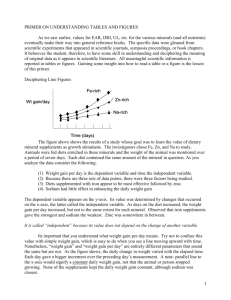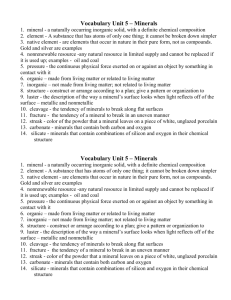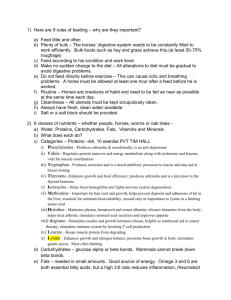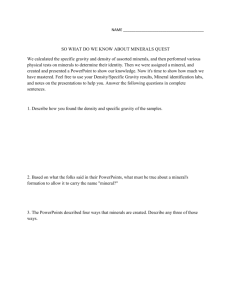The Magnificent Seven Minerals
advertisement
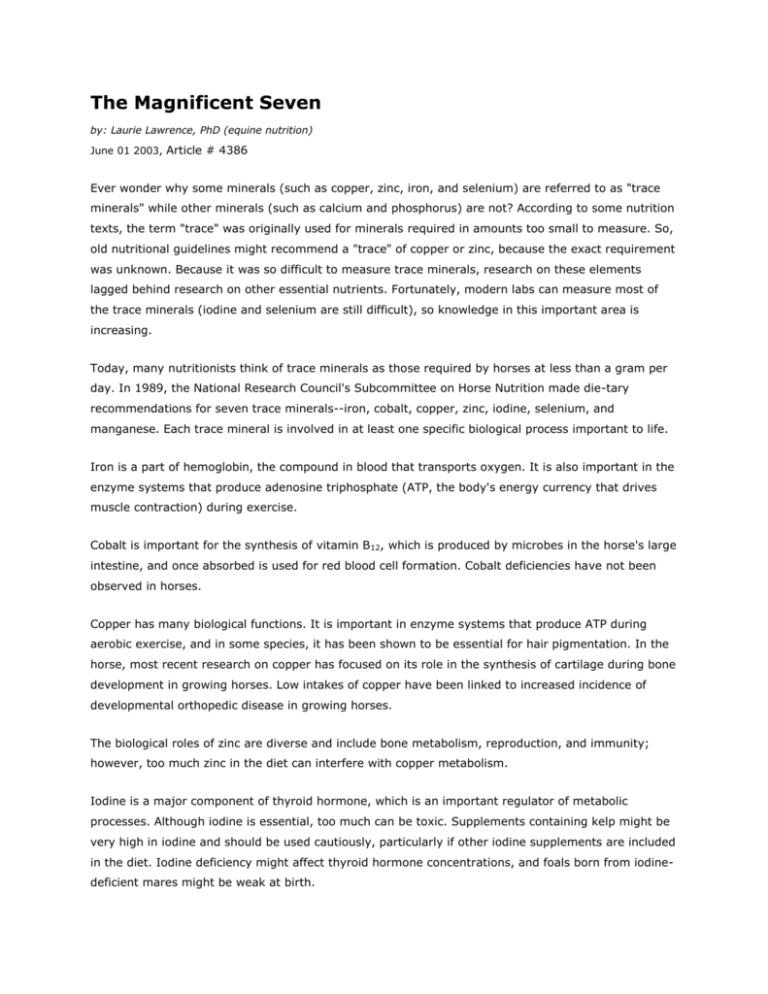
The Magnificent Seven by: Laurie Lawrence, PhD (equine nutrition) June 01 2003, Article # 4386 Ever wonder why some minerals (such as copper, zinc, iron, and selenium) are referred to as "trace minerals" while other minerals (such as calcium and phosphorus) are not? According to some nutrition texts, the term "trace" was originally used for minerals required in amounts too small to measure. So, old nutritional guidelines might recommend a "trace" of copper or zinc, because the exact requirement was unknown. Because it was so difficult to measure trace minerals, research on these elements lagged behind research on other essential nutrients. Fortunately, modern labs can measure most of the trace minerals (iodine and selenium are still difficult), so knowledge in this important area is increasing. Today, many nutritionists think of trace minerals as those required by horses at less than a gram per day. In 1989, the National Research Council's Subcommittee on Horse Nutrition made die-tary recommendations for seven trace minerals--iron, cobalt, copper, zinc, iodine, selenium, and manganese. Each trace mineral is involved in at least one specific biological process important to life. Iron is a part of hemoglobin, the compound in blood that transports oxygen. It is also important in the enzyme systems that produce adenosine triphosphate (ATP, the body's energy currency that drives muscle contraction) during exercise. Cobalt is important for the synthesis of vitamin B12, which is produced by microbes in the horse's large intestine, and once absorbed is used for red blood cell formation. Cobalt deficiencies have not been observed in horses. Copper has many biological functions. It is important in enzyme systems that produce ATP during aerobic exercise, and in some species, it has been shown to be essential for hair pigmentation. In the horse, most recent research on copper has focused on its role in the synthesis of cartilage during bone development in growing horses. Low intakes of copper have been linked to increased incidence of developmental orthopedic disease in growing horses. The biological roles of zinc are diverse and include bone metabolism, reproduction, and immunity; however, too much zinc in the diet can interfere with copper metabolism. Iodine is a major component of thyroid hormone, which is an important regulator of metabolic processes. Although iodine is essential, too much can be toxic. Supplements containing kelp might be very high in iodine and should be used cautiously, particularly if other iodine supplements are included in the diet. Iodine deficiency might affect thyroid hormone concentrations, and foals born from iodinedeficient mares might be weak at birth. Selenium and vitamin E are both anti-oxidants, and selenium deficiency can be modulated by the amount of vitamin E present in the diet. Although selenium is essential, it can also be toxic, so supplementation must be controlled. Selenium deficiency can also cause weak foals. When mares are consuming selenium-deficient diets, foals can be born with white muscle disease, which affects their hearts and skeletal muscles, often resulting in death. Manganese deficiency hasn't been seen in horses. From research in other animals, manganese is known to be involved in several metabolic processes, including cartilage formation. Unfortunately, little research on this mineral has been conducted with horses. What's in the Feed? Most commercial horses feeds are fortified with trace minerals. The concentrations of trace minerals in a commercially mixed feed are often listed on the feed tag or bag. An example of a feed tag (for an imaginary feed) is shown here. Trace mineral concentrations are usually listed in "parts per million," which is abbreviated ppm. One part per million is one milligram per kilogram of feed (1 kilogram=2.2 pounds). On the feed tag shown here, the concentration of selenium is 0.3 ppm, so each kilogram of feed contains 0.3 mg of selenium. Some feed tags or bags might give the amount of each mineral provided by a daily serving. If a horse were fed 6.6 pounds (3 kg) of the feed shown on this tag, he would receive 0.9 mg of selenium each day from this feed (3 kg x 0.3 mg/kg=0.9 mg). For each component of the guaranteed analysis, the feed tag will state whether the amount listed is a minimum or maximum. The tag almost always lists the minimum amount of a trace mineral. Feed companies are required by law to meet the minimum or maximum amount of each nutrient listed on their feed tag. If the feed were analyzed, the actual concentration of any trace mineral would usually be somewhat higher than the minimum value on the feed tag. A feed tag will also have an ingredient list that will show the sources of trace minerals added to the feed. On the feed tag shown here, supplemental manganese is provided as manganous oxide, and selenium as sodium selenite. These are examples of inorganic mineral sources. Some feeds will also include organic mineral sources. In an organic mineral source, the mineral is bound to a protein, amino acid, or carbohydrate complex. On this feed tag, zinc is provided as zinc methionine, and copper is provided as copper proteinate. Both are examples of organic mineral sources. A chelated mineral source is a type of organic complex that has a specific chemical structure. Usually an amino acid is used to chelate the mineral. Chelated means it is chemically bonded to an amino acid to improve uptake by the digestive system. If a chelated mineral source is used, the ingredient list will note the term chelate (i.e. copper amino acid chelate). Trace minerals in organic sources are believed to be more available (more easily absorbed from the digestive tract) than inorganic sources. Unfortunately, few experiments have compared organic and inorganic sources of minerals in horse feeds. A study conducted at the University of Kentucky found that there was more selenium in the milk of mares fed selenium as selenium yeast (an organic source) than in milk from mares fed selenium as sodium selenite, suggesting that the organic selenium was more easily utilized by the mares than the inorganic selenium. However, a study at Colorado State University compared the effects of providing zinc, copper, and manganese in inorganic forms or as a mix of inorganic and organic forms. Mature horses received the different diets for four months. There was no evidence that horses fed the mix of inorganic and organic forms had better absorption of the minerals or better hoof growth. Organic mineral sources are usually more expensive than inorganic sources. More research will be necessary to determine whether including organic mineral sources in horse feeds provides enough benefit to justify the additional cost. The trace mineral content of common horse feeds is very variable. Many, including alfalfa hay, grass hay, oats, and corn, are low in copper. Northeastern United States soils are low in selenium; thus, feeds harvested from that region are usually selenium-deficient. Other areas deficient or marginal in selenium include the Eastern Seaboard, Pacific Northwest, and much of the Great Lakes area. Much of Canada also has selenium-deficient soils, but selenium concentrations of feeds grown in the Great Plains areas are usually adequate. Zinc, manganese, and iron concentrations in feeds can be low, moderate, or high. As with selenium, the amounts of these minerals found in plants can be influenced by the mineral content of the soil. The local cooperative extension service should be able to provide information on any trace mineral deficiencies or excesses in a particular area. What Horses Need The level of trace minerals needed by horses will vary with body weight and physiological class. As with most nutrients, lactating mares and growing horses usually have the highest requirements, while mature, sedentary horses have the lowest requirements. Because the trace mineral content of common horse feeds can be so variable, most commercial feed mixes include trace mineral supplementation at levels adequate to satisfy requirements for particular types of horses. For example, a commercial grain mix formulated for mares and foals will usually contain higher concentrations of trace minerals than a grain mix formulated for mature pleasure horses. A feed tag should include a purpose statement giving the type of animal for which the feed is intended. On the feed tag shown on page 70, the purpose is given under the feeding directions. "Trace Minerals Needed and Provided" on page 74 shows the amount of iron, iodine, selenium, zinc, copper, and manganese in diets containing hay and oats or hay and a fortified grain mix. Also shown are the recommended minimum amounts of these minerals for an adult horse performing light to moderate work. A diet consisting of hay and plain oats appears to provide enough manganese, iron, and zinc for the mature horse, but the amounts of copper, selenium, and iodine are just barely adequate. When the oats are replaced with a manufactured fortified grain mix, all of the requirements are met. Also, included in "Trace Minerals Needed and Provided" are the daily requirements for a yearling with an expected mature body weight of 1,100-1,200 pounds (500-544 kg). The diet of hay and oats previously discussed does not meet the higher copper needs of the growing horse, and this diet might be marginal in iodine and selenium as well. When the available grain mix is used, trace mineral requirements of the yearling will be met. Horse owners commonly combine commercial grain mixes with oats or another cereal grain. This practice is not recommended because it dilutes the trace mineral fortification of the manufactured grain mix. Another practice is to feed hay and oats and depend on a trace-mineralized salt block to meet trace mineral needs. This practice might be adequate for some situations, but not for horses with higher trace mineral needs (broodmares and growing horses). Many trace-mineralized salt blocks contain low levels of copper and no selenium, two of the minerals that are marginal in diets of hay and oats. Also, consumption of trace mineralized salt might be erratic, resulting in inconsistent nutrient intakes. Deficiency and Toxicity For any nutrient, an animal's status can be described as deficient, marginal, optimal, sub-toxic, or toxic. In deficiency and toxicity, signs of poor performance or poor health will usually be evident, particularly if the animal has been consuming the deficient or toxic diet for an extended period. In contrast, separating optimal trace mineral status from marginal and sub-toxic status based on external appearance can be very difficult. For example, weanlings eating marginal levels of copper might grow the same in height and weight as foals eating higher levels of copper, but they could have a higher incidence of osteochondrosis (OCD), a defect in bone development. The OCD lesions might be discovered when the horse goes into work, when he is radiographed for a purchase exam, or they might go undetected for years. Also, while some weanlings in the marginal group will be affected, others will be normal. Finally, some OCD will occur in horses receiving the right amount of copper because OCD is a multifactorial disease with many possible causes. It is somewhat difficult to assess a horse's trace mineral status. For some minerals, blood levels reflect intake, but for other minerals, a hormone or important protein might be more sensitive. Hair analysis is sometimes used to determine whether an animal has been exposed to heavy metals such as lead. Often, a sample taken from one horse must be compared to many others to establish what is "normal" in a population. Hair analysis is easy to do, and it could be useful in determining whether horses have been exposed to toxic levels of heavy metals or other environmental contaminants. I am unaware of any published reports that conclusively link specific concentrations of trace minerals in the horse's hair to deficient, marginal, optimal, sub-toxic, or toxic status. Take-Home Message To ensure that horses get adequate trace minerals, regularly assess the horse's diet. If the amount and composition of each feed consumed by a horse is known, then the total trace mineral intake can be calculated and compared to requirements. If a particular mineral or group of minerals appears to be deficient, then add a supplement. However, in most cases, horses which receive several pounds of a good-quality mixed grain each day will be receiving adequate trace minerals, and additional supplementation will not be necessary. TRACE MINERALS NEEDED AND PROVIDED Daily Requirement Amount in Diet* Hay/Oats Hay/Grain Mineral (mg) Mature** Yearling*** Iron 400-440 350-450 Copper 100-110 175-200 90 - 120 130 - 250 Zinc 400-440 475-500 500 - 650 600 - 800 Manganese 400-440 350-400 500 - 750 600 - 1000 Iodine 1.1 1.0-2.0 1.0 - 2.0 1.5 - 2.5 Selenium 1.1 1.0-2.0 1.2 - 1.5 2.0 - 3.0 10001500 Mix**** 1100 - 2000 * WHEN THE DIET CONTAINS APPROXIMATELY 15-18 POUNDS OF HAY AND AND 6-8 POUNDS OF GRAIN ** BASED ON RECOMMENDATIONS FROM THE NATIONAL RESEARCH COUNCIL'S RECOMMENDATIONS FOR 1,100 POUND HORSES IN MODERATE WORK. *** MATURE BODY WEIGHT 1,100-1,200 LBS. (500-544 KG). SOURCE: ROBINSON, N.E.; DEVELOPMENTAL ORTHOPEDIC DISEASE. CURRENT THERAPY IN EQUINE MEDICINE, W.B. SAUNDERS CO., 1992. **** BASED ON TYPICAL GRAIN MIXES CONTAINING 1214% CRUDE PROTEIN AND FORMULATED TO MEET THE NEEDS OF PERFORMANCE HORSES OR GROWING HORSES. RANGES ARE GIVEN BECAUSE INDIVIDUAL FEEDS WILL VARY. ANATOMY OF A FEED TAG Forti-Feed Name of Feed Guaranteed Analysis: Crude protein (min) 14% Crude fat (min) 3% Crude fiber (max) 8% Calcium (min) 0.70% Minimum or maximum amount Calcium (max) 0.90% of nutrient in the feed Phosphorus (min) 0.50% Copper (min) Zinc (min) Manganese (min) 40 ppm 100 ppm 50 ppm Selenium (min) 0.3 ppm Ingredients: Oats, corn, soybean meal, forage products, cane molasses, dicalcium phosphate, calcium Sources of nutrients in the feed carbonate, salt, zinc methionine, copper proteinate, manganous oxide, sodium selenite Feeding Directions: Feed 1/2 to 1 lb per 100 lb of body weight daily to broodmares. Feed with goodquality hay or pasture. Manufactured by FEEDS-R-US, Inc. Rt. 1, Our Town, USA Describes type of horse this feed is intended for and recommended amounts to be fed Name of company manufacturing the feed
